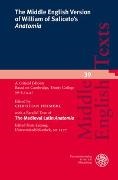Read more
This edition sets out in parallel texts the Latin original and the Middle English translation of the medieval medical text, the 'Anatomia', which in its original form is the fourth book of the 'Chirurgia' by William of Saliceto (?1210-?1285), the influential and innovative Italian doctor and surgeon. Saliceto was the first medieval medical practitioner to attempt to reunite surgery and medicine, and the 'Anatomia' describes "a capite ad cacem" those parts of the body and their positions that are important for a surgeon. The 'Anatomia' founded the genre of topographical or regional anatomy. The Introduction explores whether and to what degree the three manuscripts of this Middle English translation of the 'Anatomia' are indicative of the early development of Middle English medical terminology. The evidence shows a significant increase in the number of medical words in the fourteenth and fifteenth century, when English authors regained confidence in the subject through a wave of translations. Apart from a number of words and phrases that are recorded in the three manuscripts for the first time, these witnesses of the Middle English 'Anatomia' illustrate confusion in the search for a common English medical terminology, although the treatise also shows a tendency towards a unified anatomical vocabulary based on Latin. The edition includes a Commentary and Glossary along with four appendices of related materials.
Summary
This edition sets out in parallel texts the Latin original and the Middle English translation of the medieval medical text, the 'Anatomia', which in its original form is the fourth book of the 'Chirurgia' by William of Saliceto (?1210-?1285), the influential and innovative Italian doctor and surgeon. Saliceto was the first medieval medical practitioner to attempt to reunite surgery and medicine, and the 'Anatomia' describes "a capite ad cacem" those parts of the body and their positions that are important for a surgeon. The 'Anatomia' founded the genre of topographical or regional anatomy. The Introduction explores whether and to what degree the three manuscripts of this Middle English translation of the 'Anatomia' are indicative of the early development of Middle English medical terminology. The evidence shows a significant increase in the number of medical words in the fourteenth and fifteenth century, when English authors regained confidence in the subject through a wave of translations. Apart from a number of words and phrases that are recorded in the three manuscripts for the first time, these witnesses of the Middle English 'Anatomia' illustrate confusion in the search for a common English medical terminology, although the treatise also shows a tendency towards a unified anatomical vocabulary based on Latin. The edition includes a Commentary and Glossary along with four appendices of related materials.

